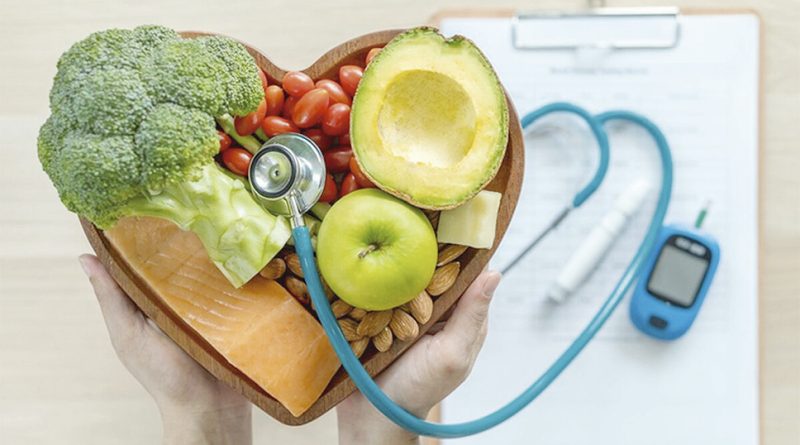Consejos para reducir el riesgo de padecer colesterol elevado / High cholesterol: Six ways to lower your cholesterol levels and reduce your risk of stroke
Una de las recomendaciones es evitar el exceso de sal, pues aunque es necesaria en grandes cantidades provoca daños en riñones, venas, arterias, infartos y accidentes cerebrovasculares
El sedentarismo después de meses de aislamiento y múltiples situaciones de estrés y ansiedad dificultan planear y seguir una correcta alimentación con comidas en horarios establecidos y de alto contenido de nutrientes, lo que hace que haya más riesgo de padecer colesterol elevado.
Sin duda hay problemas, pero lograr mantener el cuerpo sano es posible. Se requiere de una alimentación adecuada a la edad, peso, condición de salud y estilo de vida, la práctica constante de ejercicio y el compromiso por mantener buenos hábitos como el consumo de agua, dormir entre 7 y 8 horas al día y evitar los excesos.
Haz que cada plato sea uno placentero. La cuestión es sencilla: planea un menú semanal. Cuando no lo haces, pierdes tiempo cada día al pensar qué preparar, realizando compras y cocinando. Si organizas un menú semanal, puedes enfocar estos esfuerzos en uno o dos días donde cuentes con más tiempo, ahorras dinero y evitas consumir comida exprés con nulo aporte nutricional.
Reduce el consumo de grasas. Cocina a la parrilla, asado, al horno, hervido o al vapor. Evita los guisos empanizados y capeados; sustituye quesos, crema y mantequilla por cottage, requesón o yogur natural.
No endulces de más. Reduce azúcares, aumenta la ingesta de fruta como postre, toma agua natural en lugar de bebidas endulzadas, evita los productos que aporten más de 10 gramos de azúcar por cada porción.
Evita los alimentos procesados. Es bueno bajarle a la sal, es un nutriente necesario para que el cuerpo cuente con la conducción óptima de cargas eléctricas que estimulen el sistema nervioso, pero si se consume en grandes cantidades provoca daños en riñones, venas, arterias, infartos y accidentes cerebrovasculares. Reduce su uso en la cocina con ayuda de hierbas de olor, especias, cebolla, ajo, pimienta y ajonjolí.
Fomenta el color en tus platillos. Combina ingredientes de tonos coloridos; combina calientes con frescos.
Alimenta tu mente con meditación. Esto te ayudará a mantener el control de tus emociones, relajarte y canalizar tus energías.
High cholesterol: Six ways to lower your cholesterol levels and reduce your risk of stroke
HIGH cholesterol causes fatty deposits to build up in your arteries, making them stiff and narrow. This makes it increasingly difficult for blood to flow through, and it increases the chance of a blood clot forming. How can you lower your cholesterol levels?
Too much cholesterol increases your risk of a deadly stroke. Thus, reducing your cholesterol levels can help save your life. How do you do this?
The Stroke Association explained eating too much saturated fats (such as butter) can increase cholesterol levels.
Cholesterol is carried in the blood by proteins called lipoproteins; there are two types:
-Low-density lipoprotein (LDL)
-High-density lipoprotein (HDL)
LDL “carries cholesterol from your liver to the cells that need it”, but it can build up in your artery walls if there is too much.
HDL carries LDL “away from the cells and back to the liver, where it’s broken down or passed out the body”.
When there’s too much LDL cholesterol, it can have adverse effects on your health.
The condition has no noticeable symptoms, therefore it’s important to get your levels checked by a blood test.
This is especially important if you have a high risk profile; this includes being over 40, being overweight, high blood pressure or diabetes.
You must also be on top of your cholesterol levels if you have a history of heart disease or high cholesterol runs in your family.
Ban trans fats
To reduce your cholesterol levels, WebMD suggests banning trans fats from your diet.
Cardiologist Suzanne Steinbaum explained: “They raise your LDL, lower your HDL, and increase your risk of developing heart disease and stroke.”
Found in fried foods, baked goods (such as frozen pizza), look out for “hydrogenated oil” on food packaging – it’s another name for trans fats.
Lose weight
WebMD certified that dropping 10lbs if you’re overweight will cut your LDL levels by up to eight percent.
It’s reasonable and safe to lose between one to two pounds each week (and no more).
Exercise
Another cardiologist Sarah Samaan said: “Exercising at least two-and-a-half hours a week is enough to raise HDL and improve LDL.”
This can be achieved by working out in 10-minute chunks throughout the day.
Fibre foods
Foods high in soluble fibre – such as oatmeal, apples, prunes and beans – keep the body from absorbing cholesterol.
WebMD stated: “Research shows that people who ate five to 10 more grams of it each day saw a drop in their LDL .”
In addition, fibre helps you to feel fuller for longer, so any cravings for snacks can be diminished.
To avoid abdominal cramping or bloating, it’s advisable to increase your fibre intake slowly.
Nutty snacks
If you do still crave a snack, try a small portion of nuts; this is because they contain sterols.
Sterols too can keep the body from absorbing cholesterol. However, nuts are high in calories, so do keep portion control in mind.
Destress
Feelings of stress can increase cholesterol levels, according to WebMD. Thus, taking time to relax may help.
Keep your cholesterol levels in check by reading an engaging book, or going for a leisurely walk.
By CHANEL GEORGINA



 (1) (2).jpg)


Debe estar conectado para enviar un comentario.